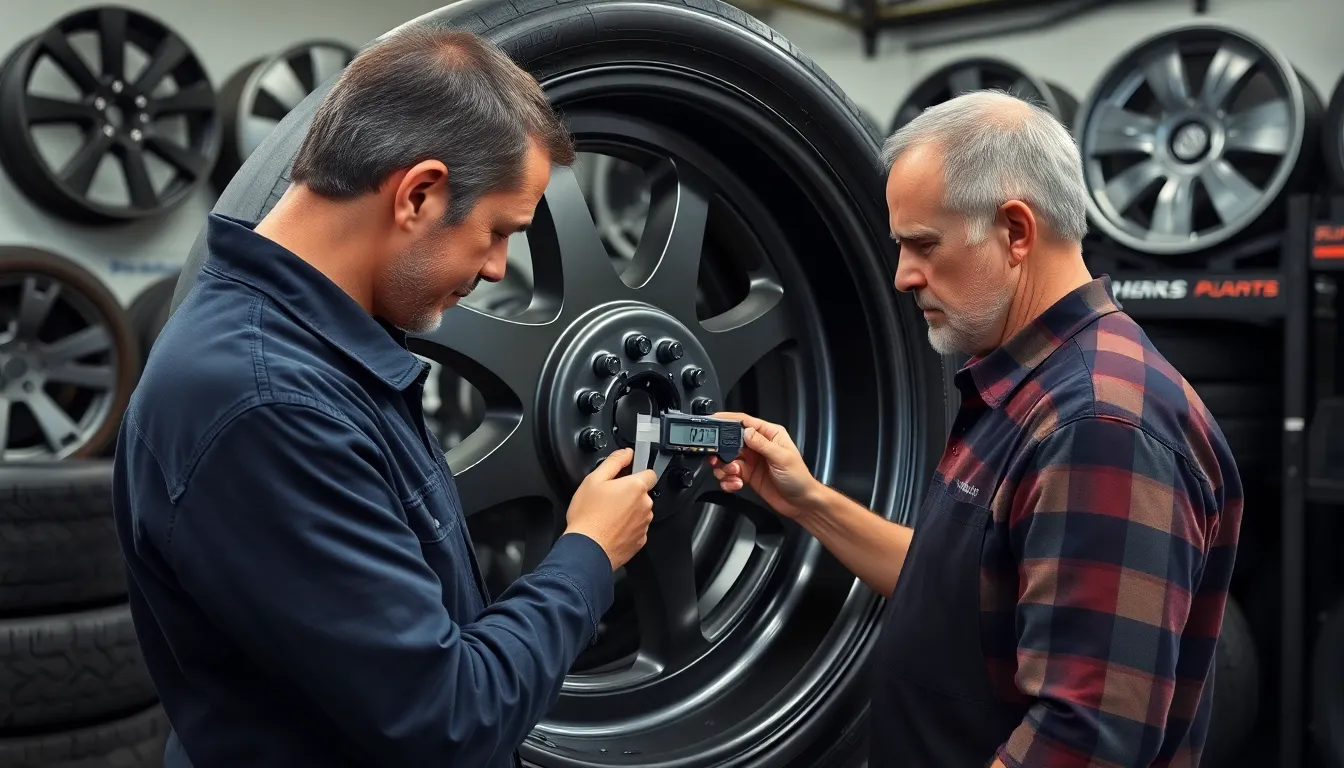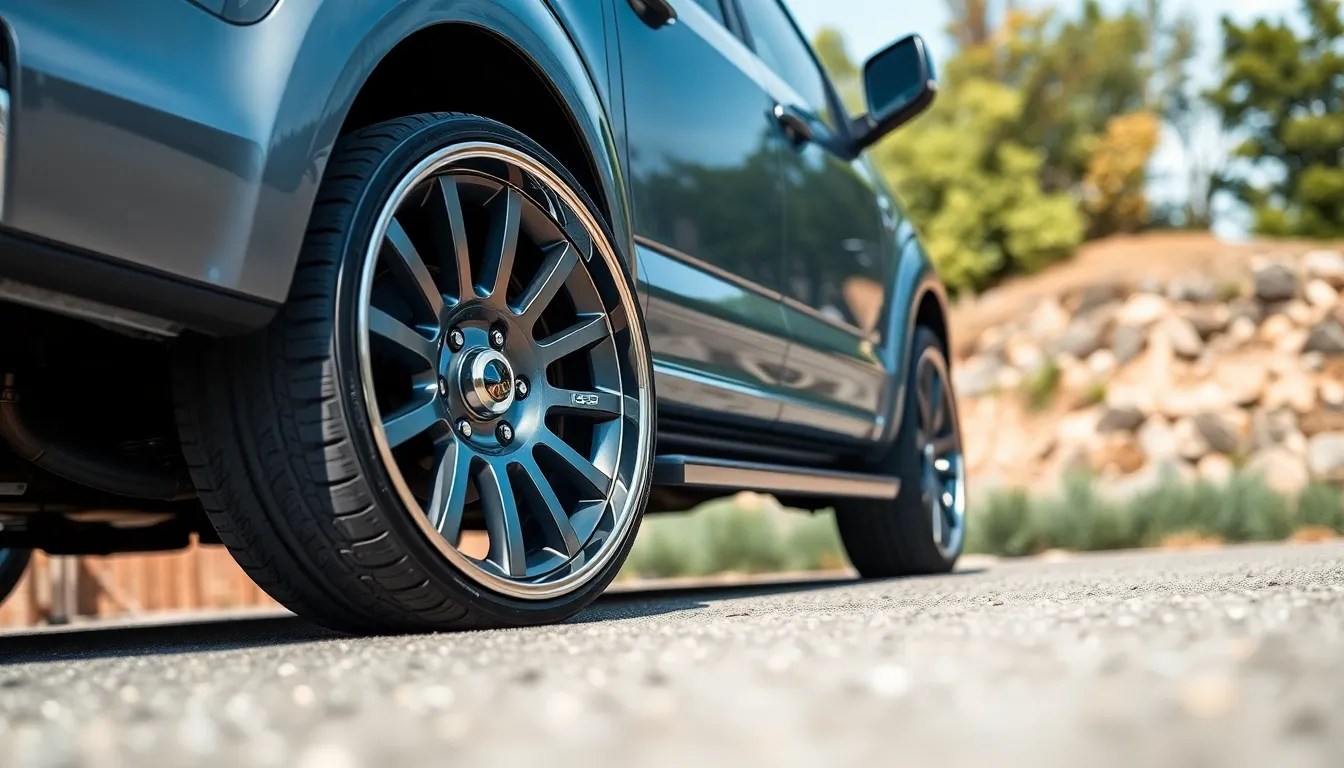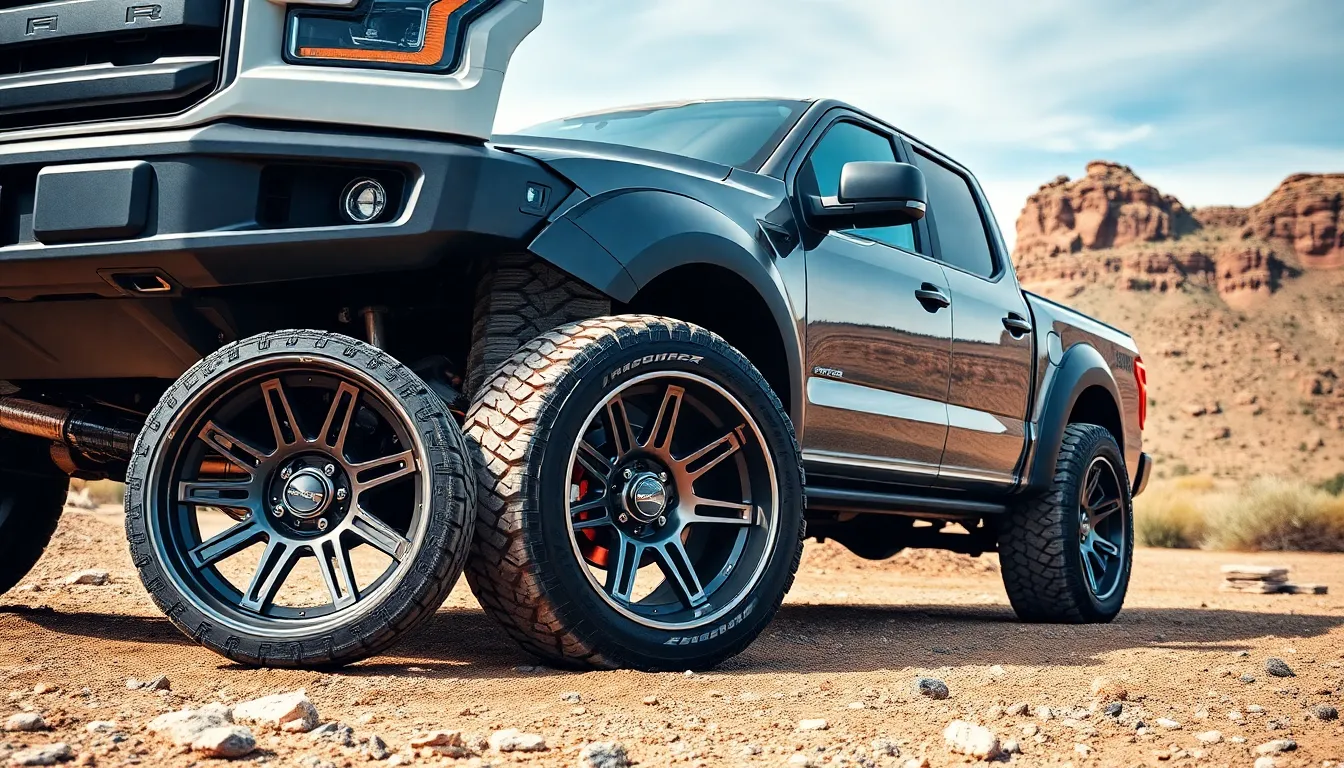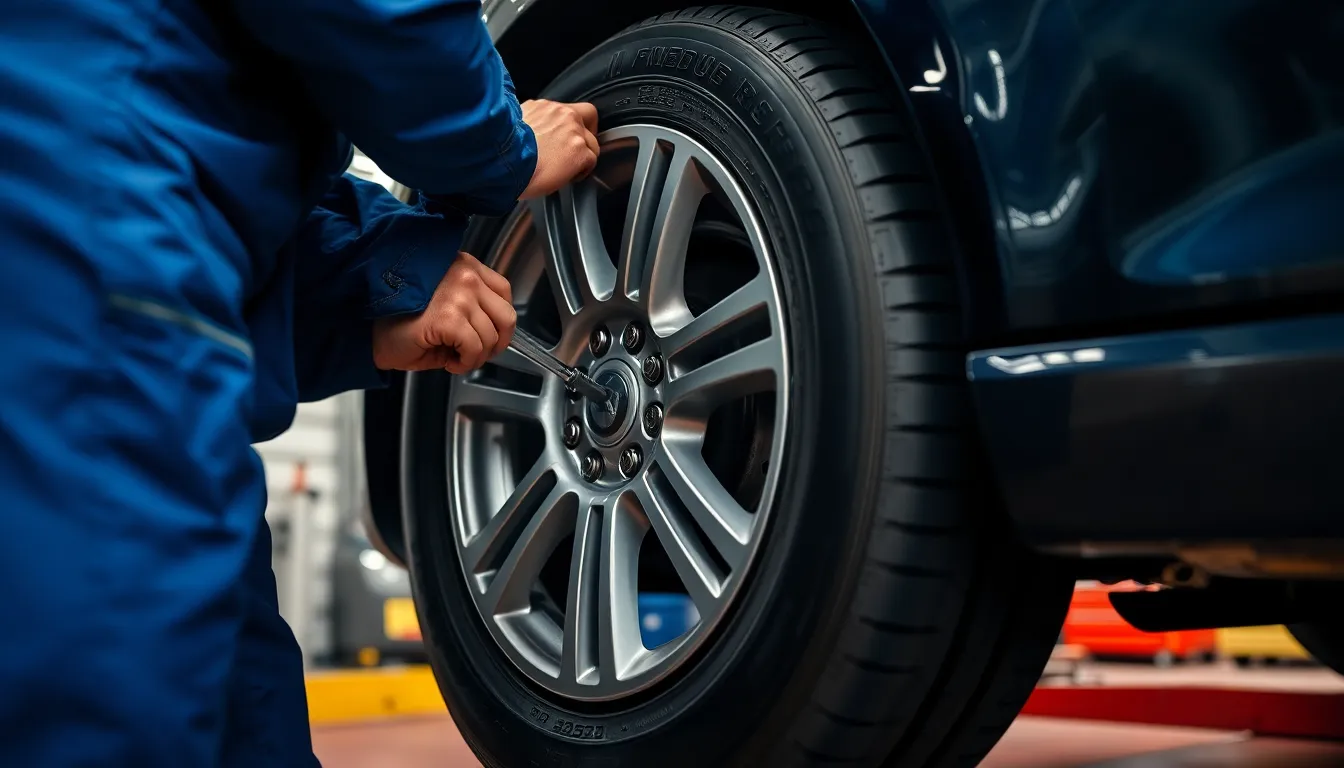When we’re upgrading our wheels and tires we often wonder exactly how much our new setup will stick out from the vehicle. Wheel offset plays a crucial role in determining this final stance and it’s something every car enthusiast needs to understand before making a purchase.
Getting the offset calculation wrong can lead to wheels that either sit too far inboard or poke out beyond the fenders in ways we didn’t expect. We’ve all seen vehicles with wheels that just don’t look right – either tucked too deep under the fenders or extending dangerously past the wheel wells.
Understanding how to calculate offset and predict the final fitment will save us from costly mistakes and help achieve that perfect aggressive stance we’re after. Let’s jump into the math behind wheel offset and learn exactly how far different offset measurements will make our wheels stick out.
What Is Wheel Offset and How Does It Work
Wheel offset measures the distance between the wheel’s mounting surface and its centerline. This measurement determines how far your wheel sits inboard or outboard from the hub mounting point on your vehicle.
Three primary types of offset exist in the automotive industry:
- Positive offset positions the mounting surface toward the wheel’s face, pushing the wheel closer to the vehicle’s body
- Negative offset places the mounting surface toward the wheel’s back, extending the wheel outward from the fender
- Zero offset centers the mounting surface exactly at the wheel’s midpoint
Manufacturers engineer original equipment wheels with exact offset values to maintain proper suspension geometry. These factory specifications ensure optimal handling characteristics and prevent interference with suspension components or brake calipers.
The offset measurement uses millimeters as its standard unit. A wheel marked “+35” features 35 millimeters of positive offset, while “-15” indicates 15 millimeters of negative offset. We calculate this by measuring from the wheel’s centerline to the mounting hub surface.
| Offset Type | Mounting Position | Wheel Placement | Common Range |
|---|---|---|---|
| Positive | Toward face | Inboard | +10mm to +50mm |
| Zero | At centerline | Neutral | 0mm |
| Negative | Toward back | Outboard | -10mm to -30mm |
Changing your wheel’s offset directly affects how far the tire extends beyond your fender line. Lower offset numbers push wheels further outward, creating that aggressive stance many enthusiasts desire. Higher offset values tuck wheels deeper into the wheel wells.
Track width changes occur when we modify offset measurements. Each millimeter of offset change moves the wheel 1 millimeter in the corresponding direction. Reducing offset by 20mm extends each wheel 20mm further from the vehicle’s centerline.
Understanding backspacing helps clarify offset relationships. Backspacing measures the distance from the wheel’s mounting surface to its inner edge. We can convert between these measurements using the wheel width and offset specifications.
Measuring Offset Stick Out: The Basics

Measuring offset stick out requires understanding the precise relationship between wheel centerline and mounting surface distance. We measure this critical dimension in millimeters and categorize it into three distinct types that directly affect wheel positioning.
Positive Offset Explained
Positive offset positioning places the mounting surface closer to the street side of the wheel. This configuration creates increased backspacing that pushes the wheel deeper into the wheelwell. Larger positive offset values result in more recessed wheel placement as the mounting point moves further toward the outer edge. Most factory wheels feature positive offset ranging from +35mm to +50mm to maintain proper suspension geometry. Vehicles with positive offset demonstrate reduced wheel protrusion beyond the fender line.
Negative Offset Explained
Negative offset moves the mounting surface farther from the street side toward the vehicle’s inner section. This arrangement reduces backspacing and causes wheels to extend outward from the wheelwell significantly. Larger negative offset measurements create more dramatic wheel protrusion as the mounting point shifts toward the inner wheel edge. Off-road vehicles and custom builds commonly use negative offset ranging from -12mm to -44mm for aggressive stance appearance. Wheels with negative offset extend beyond the original fender line positioning.
Zero Offset Explained
Zero offset occurs when the mounting surface aligns exactly with the wheel’s centerline measurement. This configuration typically produces flush wheel positioning relative to the vehicle body panels. Zero offset creates balanced wheel placement without inward tucking or outward extension. Classic muscle cars and certain truck applications originally featured zero offset specifications for optimal weight distribution. Wheels with zero offset maintain the original manufacturer’s intended wheel well relationship.
Factors That Determine How Far Offset Will Stick Out

Three primary factors work together to determine the exact distance your wheels extend beyond the vehicle’s mounting surface. Understanding these elements allows us to predict wheel placement accurately before installation.
Wheel Width Impact
Wheel width directly affects how far the offset positions the wheel relative to the hub centerline. Wider rims create more surface area that extends outward from the mounting point, influencing the overall stick-out distance regardless of offset values.
The measurement spans from the front flange to the back flange of the rim, establishing the baseline for all offset calculations. A 10-inch wide wheel naturally provides more material to position closer or farther from the hub compared to an 8-inch wheel. Manufacturers measure this width across the barrel section where the tire bead seats against the rim.
Increasing wheel width by 2 inches typically adds 1 inch of stick-out distance when maintaining the same offset. This relationship occurs because the additional width distributes equally on both sides of the centerline, pushing the outer edge further from the vehicle body.
Backspacing Considerations
Backspacing measures the distance from the mounting surface to the back edge of the wheel rim, determining available clearance between the wheel and suspension components. This measurement directly correlates with offset calculations and affects how far the wheel extends outward.
Measuring backspacing helps calculate the precise offset value using the formula: Offset = Backspacing – (Wheel Width ÷ 2). Reducing backspacing by 1 inch effectively decreases offset by the same amount, pushing the wheel further from the vehicle body.
Insufficient backspacing can cause the wheel to contact brake calipers, suspension arms, or steering components. Excessive backspacing pulls the wheel too far inward, potentially creating clearance issues with the inner fender well or affecting suspension geometry.
Vehicle-Exact Measurements
Every vehicle features unique wheel arch dimensions and clearance specifications that limit the maximum offset and width combinations. These factory measurements determine the safe range of stick-out distances without causing tire rubbing or interference.
Measuring from the mounting surface outward provides the baseline for calculating stick-out distance with any given offset. Vehicles with larger wheel wells accommodate more aggressive offset setups, while compact cars require conservative measurements to maintain proper clearance.
Factory wheel specifications serve as the starting point for determining safe offset ranges. Most manufacturers design original equipment with positive offset values between 35mm and 55mm to maintain proper suspension geometry and handling characteristics.
Calculating Offset Stick Out for Your Vehicle

Determining wheel stick-out distance requires precise mathematical calculations using offset measurements and wheel dimensions. We calculate this distance by understanding the relationship between wheel centerline positioning and mounting surface placement relative to your vehicle’s hub.
Using Offset Formulas
Converting backspacing measurements to offset provides the foundation for calculating stick-out distance accurately. We use the formula: Offset = (Wheel Width ÷ 2) – Backspacing, with all measurements converted to millimeters for standard calculations.
Positive offset calculations demonstrate wheels positioned closer to the vehicle’s body, reducing outward extension from the fender line. A 10-inch wide wheel with 6 inches of backspacing creates a positive 25.4mm offset (1 inch converted to millimeters), indicating the mounting surface sits 25.4mm toward the street side from the wheel’s centerline.
Negative offset formulas reveal wheels extending farther outward from the vehicle’s body, increasing stick-out distance significantly. When backspacing measures less than half the wheel width, we calculate negative offset values that directly correlate to increased outward projection from the hub mounting point.
Zero offset calculations occur when backspacing equals exactly half the wheel width, positioning the mounting surface at the wheel’s centerline. This configuration creates a neutral stance where stick-out distance depends entirely on wheel width and vehicle-exact clearances.
Measuring Tools and Techniques
Precise measuring tools ensure accurate offset calculations and stick-out predictions for your exact vehicle setup. We recommend using digital calipers for backspacing measurements, measuring from the hub mounting surface to the wheel’s inner edge with 0.1mm accuracy.
Online wheel offset calculators streamline the calculation process by inputting current wheel specifications and comparing them against proposed setups. These digital tools visualize stick-out differences between various offset combinations, helping predict fitment outcomes before purchasing new wheels.
Wheel visualizers on platforms like TireSize.com display how offset changes affect your vehicle’s appearance and clearance requirements. We input wheel width, offset values, and vehicle specifications to generate side-by-side comparisons showing exact stick-out distances and potential clearance issues.
Professional measuring techniques include using straight edges and rulers to verify backspacing measurements on mounted wheels. Measuring from the hub face to the wheel’s inner lip provides the backspacing dimension needed for offset calculations, ensuring accuracy when determining stick-out projections for different wheel configurations.
Common Offset Ranges and Their Effects

Wheel offset measurements determine how far your wheels sit inboard or outboard from the mounting point. Different offset ranges create distinct visual and functional effects on vehicle stance and handling.
Standard Factory Offsets
Manufacturers select exact offset values to ensure proper fit while maintaining safe handling and steering response. Most passenger vehicles use positive offset wheels ranging from +35mm to +45mm, which tuck wheels under the vehicle for better fender clearance and stability.
Sedans and SUVs typically feature factory offsets between +35mm and +45mm to optimize handling characteristics. Trucks often use offsets from +15mm to +25mm depending on the exact model and intended use. These factory specifications prevent wheel rubbing against suspension components while maintaining proper load distribution across wheel bearings.
Factory positive offsets place the mounting surface toward the wheel’s face, creating deeper backspacing that keeps wheels closer to the vehicle body. This configuration improves aerodynamics and reduces stress on suspension components compared to aggressive aftermarket setups.
Aftermarket Offset Options
Aftermarket wheels frequently use different offset measurements to modify vehicle stance or accommodate performance upgrades like larger brake systems. Lower positive offsets or negative offsets push wheels outward from the vehicle body, creating a more aggressive appearance but potentially reducing clearance.
Common aftermarket offset ranges include zero to negative values, with many off-road and truck applications using offsets from 0mm to -44mm or more extreme. Replacing a factory +45mm offset wheel with a +20mm offset wheel creates a 25mm outward shift, moving the wheel’s outer edge farther from the vehicle body.
Negative offset wheels move the mounting surface behind the wheel’s centerline, pushing the entire wheel assembly outward and sometimes extending beyond the fender line. Extreme negative offsets can require fender modifications or flares to prevent tire contact with body panels during suspension compression or steering input.
Aftermarket options allow customization of wheel positioning, but dramatic offset changes can increase wear on suspension components and alter handling characteristics compared to factory specifications.
Visual and Performance Impact of Offset Changes

Offset changes create noticeable visual differences and significantly affect vehicle performance characteristics. Understanding these impacts helps us make informed decisions when selecting aftermarket wheels.
Appearance Modifications
Positive offset moves the mounting surface closer to the front face of the wheel, bringing wheels inward toward the vehicle body. This configuration creates a more tucked-in appearance under the fender line and enhances vehicle stability through improved weight distribution. Excessive positive offset can cause tire contact with suspension components, limiting steering lock and creating potential clearance issues.
Negative offset positions the mounting surface closer to the back of the wheel, pushing wheels outward beyond the original fender line. Trucks and off-road vehicles commonly use this configuration to achieve an aggressive stance that improves stability on rough terrain. The outward wheel placement creates a wider track width and more commanding road presence.
Zero offset aligns the mounting surface with the wheel’s centerline, producing a centered appearance without important inward or outward positioning. This balanced configuration maintains the original vehicle proportions while allowing for modest wheel upgrades without dramatic stance changes.
Handling and Suspension Effects
Positive offset benefits stability and handling characteristics, particularly in front-wheel-drive vehicles where weight distribution affects traction and steering response. The inward wheel positioning reduces stress on wheel bearings and maintains factory suspension geometry for optimal performance. Front-wheel-drive systems experience improved handling stability when positive offset values remain within manufacturer specifications.
Negative offset enhances stability during off-road conditions by widening the vehicle’s track width and lowering the center of gravity. But, excessive negative offset increases stress on wheel bearings and suspension components, potentially causing premature wear or failure. The outward wheel positioning alters suspension geometry and can affect steering feel and responsiveness on paved surfaces.
Changes in offset beyond 5mm from factory specifications can affect suspension geometry and create performance impacts that vary by vehicle type. Excessive offset modifications lead to component contact, altered scrub radius, and changes in steering characteristics that may compromise vehicle safety and handling predictability.
Safety Considerations When Changing Offset

Clearance issues represent the most immediate danger when changing wheel offset beyond factory specifications. Incorrect offset causes wheels or tires to rub against suspension components, brake calipers, or bodywork during normal driving conditions. We see catastrophic mechanical failures develop when this rubbing goes undetected, as constant friction weakens critical vehicle systems over time.
Vehicle control deteriorates significantly when offset modifications alter suspension geometry beyond design parameters. Handling characteristics change unpredictably as the scrub radius shifts, creating instability during cornering, braking, and emergency maneuvers. We observe increased accident risks in vehicles where offset changes exceed manufacturer recommendations, particularly during high-stress driving situations.
Tire damage accelerates rapidly when excessive offset causes constant contact with vehicle components. Rubbing creates abnormal wear patterns that compromise tire integrity and can lead to sudden blowouts at highway speeds. We document cases where minor offset miscalculations result in complete tire destruction within hundreds of miles rather than the expected thousands.
Wheel stress increases exponentially when operating outside intended offset ranges, as the mounting point experiences forces beyond design specifications. Structural fatigue develops in wheel materials under these conditions, creating fracture points that compromise overall wheel integrity. We’ve tracked wheel failures directly attributable to excessive offset modifications that exceeded safe operational limits.
Legal and insurance complications arise when offset modifications change original equipment specifications beyond acceptable tolerances. Local regulations in many jurisdictions restrict wheel modifications that affect vehicle safety systems or alter crash performance characteristics. We find insurance coverage becomes void in accidents involving vehicles with non-compliant modifications, leaving owners financially exposed.
| Safety Factor | Risk Level | Recommended Limit |
|---|---|---|
| Clearance Issues | High | Check all contact points |
| Vehicle Control | Critical | Stay within 5mm of factory |
| Tire Damage | High | Monitor for rubbing signs |
| Wheel Stress | Medium | Use manufacturer specifications |
| Legal Compliance | Variable | Verify local regulations |
Testing and verification become essential before finalizing any offset changes, as clearance problems aren’t always visible during static inspection. We recommend full suspension compression tests and steering lock checks to identify potential contact points before road use. Professional installation ensures proper torque specifications and safety protocols are followed during wheel mounting procedures.
Conclusion
Understanding wheel offset isn’t just about achieving the perfect stance – it’s about making informed decisions that balance aesthetics with safety and performance. We’ve covered the technical aspects of calculating stick-out distance and the critical factors that influence wheel positioning.
The key takeaway is that proper planning prevents costly mistakes. By measuring your current setup and using the formulas we’ve discussed you can predict exactly how new wheels will fit your vehicle.
Remember that every modification carries responsibility. While aggressive fitment looks appealing the safety considerations we’ve outlined shouldn’t be ignored. Professional consultation and thorough testing ensure your wheel upgrade enhances your driving experience without compromising vehicle integrity.
Take your time with measurements verify clearances and prioritize safety over style. Your vehicle and wallet will thank you for the careful approach.
Frequently Asked Questions
What is wheel offset?
Wheel offset measures the distance between the wheel’s mounting surface and its centerline. It determines how far the wheel sits inboard or outboard from the hub mounting point. This measurement is crucial for proper wheel fitment and affects your vehicle’s stance, handling, and clearance with suspension components.
What are the three types of wheel offset?
The three primary types are positive, negative, and zero offset. Positive offset pushes the wheel closer to the vehicle’s body, negative offset extends it outward for a more aggressive stance, and zero offset centers the wheel at its midpoint. Each type affects wheel placement and vehicle appearance differently.
How does changing wheel offset affect my vehicle?
Changing offset impacts tire placement relative to the fender line and affects suspension geometry. Lower offset numbers create a more aggressive stance but can stress suspension components. Changes beyond 5mm from factory specifications may alter handling characteristics and potentially cause clearance issues with brakes or bodywork.
What is the difference between wheel offset and backspacing?
Backspacing measures the distance from the wheel’s mounting surface to its inner edge, while offset measures from the mounting surface to the centerline. You can convert between these measurements using wheel width specifications. Both measurements help determine proper wheel fitment and clearance.
Can incorrect wheel offset be dangerous?
Yes, incorrect offset can create serious safety risks. It may cause rubbing against suspension components, brake calipers, or bodywork, potentially leading to mechanical failures. Altered suspension geometry can deteriorate vehicle control, increase accident risks, and cause accelerated tire wear or blowouts during driving.
How do I calculate how far my wheels will stick out?
Three primary factors determine stick-out distance: wheel width, backspacing, and vehicle-specific measurements. Wider rims create more surface area extending outward. Generally, increasing wheel width by 2 inches adds approximately 1 inch of stick-out distance when maintaining the same offset specifications.
What tools help predict wheel fitment before purchasing?
Precise measuring tools and wheel visualizers help predict fitment outcomes and identify potential clearance issues. Professional wheel fitment calculators can show how different offset and width combinations will affect your vehicle’s stance and clearance before you make expensive purchasing decisions.
Are there legal considerations with wheel offset modifications?
Yes, non-compliant wheel modifications may violate local regulations and create insurance complications. Some jurisdictions have specific requirements for wheel and tire modifications. It’s essential to verify local laws and inform your insurance provider about any modifications to avoid legal and coverage issues.




